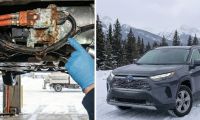Scam Opportunity Due to Hurricane Ian
One of the fallacies of used cars is believing that when a car is legally totaled, that it stays dead and has no value to anyone anymore, save for some parts salvaging.
However, according to a timely Consumer Reports reminder, this practice does not prove to be totally true. In fact, a significant number of flood damaged cars wind up repaired well enough to start, and then are flipped for resale to unsuspecting used car buyers, adding yet another used car scam to worry about.
Related article: How to Spot a Used Car Being Flipped After a Hurricane
This message was recently reinforced by a FOX Business news report quoting NICB (National Insurance Crime Bureau) president and CEO David Glawe stating that, "We anticipate a significant amount of flooded-out vehicles to be cleaned up and then resold either in the state of Florida or probably in other states, which is very common."
Mr. Glawe pointed at the high demand and low supply of vehicles in the U.S. market making this scam opportunity particularly attractive to criminals.
"The market's good, and this is just another opportunity for criminal enterprises to pay for these vehicles in Florida that have been lost and then ship them up and resell them in other states."
Quick Tips You Can Use to Spot a Flood Damaged Car
With these warnings in mind, here is a summary of some quick tips from CR automotive experts that you can use to initially spot a potentially flood damaged car before deciding to go further with a more thorough inspection:
• Check the interior of the car for a moldy or musty smell---especially near the floorboard carpeting and seats.
• Check the seat-mounting screws—both to see whether there’s any evidence that they were removed to dry the carpets effectively and/or that water damaged seats were removed and even replaced.
• Check under the doorway trim panel---evidence of mud, dirt or sand can be found trapped under these areas from rising flood water.
• Check the trunk area---that sound baffling material in the truck will absorb water and smell moldy after a flood. At the same time look for signs of rust around screw heads and even the jack.
• Check the headlights and the engine bay firewall for highwater marks---just like the banks of a river that rises and falls, a telltale waterline residue will indicate flood exposure on the headlight lens and reflector as well as the engine bay firewall baffle.
• Check that ALL of the electrics on the vehicle work---this includes the radio and speaker system, interior and exterior lighting, power plug ports, dash panel lights, electric windows and electric seat adjustment controls. However, be aware that sometimes damage to the electrical system does not manifest until months after the flood, as corrosion can take some time to eventually affect the electronics.
And finally…
For additional articles that are more thorough about the used car flood-damage problem and how to protect yourself, here are some selected articles that are very useful:
• Used Car Seller Tricks to Resurrect a Flood Damaged Car
• An Important Used Car Hidden Damage Warning for Used Car Shoppers
• If Your Car Is Damaged in a Storm, Do This Not That When It Comes to Floods
COMING UP NEXT: Best Car Tires of 2022 Update from Consumer Reports
Timothy Boyer is a Torque News automotive reporter based in Cincinnati. Experienced with early car restorations, he regularly restores older vehicles with engine modifications for improved performance. Follow Tim on Twitter at @TimBoyerWrites for daily new and used vehicle news.
Image Source: Unsplash











